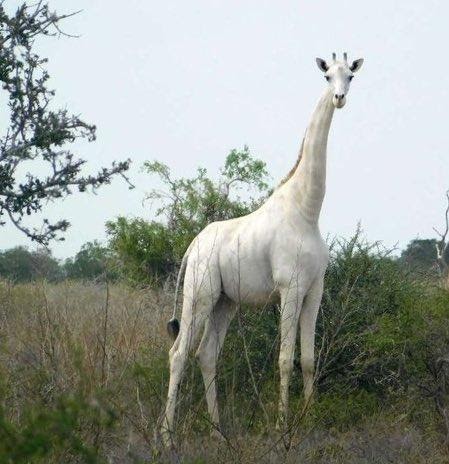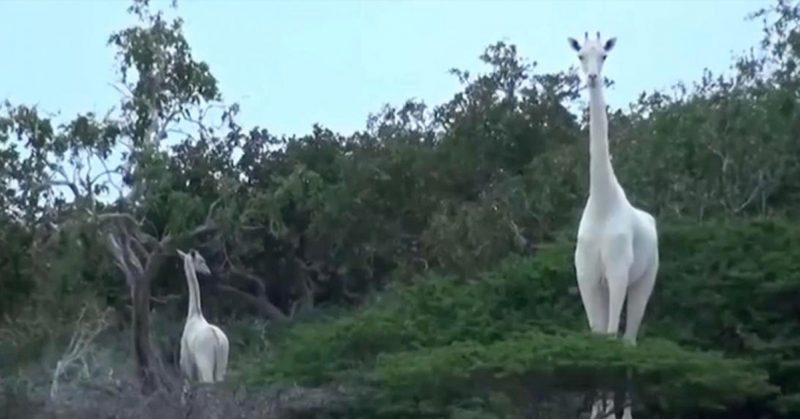Poachers are such nuisances. They have no care in the world about the conservation of wildlife. All they’re interested in is killing the rarest animals just to make money.
Rare white giraffes killed by poachers
Referring to these giraffes as ‘rare’ is an understatement. Conservationists say there’s only one such giraffe left in the world. Two white giraffes — a mother and her 7-month-old calf — were shot and killed by poachers in Garissa county, Eastern Kenya.

According to the Hirola Community Conservancy, their bodies were discovered by locals “in a skeletal state.” Sadly, the perpetrators of the act are still at large, although finding them would not bring these unique creatures back. [1]
“This is a very sad day for the community of Ijara and Kenya as a whole. We are the only community in the world who are custodians of the white giraffe,” said Mohammed Ahmednoor, Manager of the Ishaqbini Hirola Community Conservancy. He said the giraffes were last seen a little over three months ago.
“Its killing is a blow to the tremendous steps taken by the community to conserve rare and unique species and a wake-up call for continued support to conservation efforts,” he continued. [2]
The people of Kenya are disappointed by the killings as they all took pride in having the unique animals in their country. It was after the animals were not seen for a couple of months that people became worried.
According to the Kenyan wildlife service, “The management of the conservancy informed us of the missing giraffe and calf after failing to see them for a period of time.”
They then launched an official search after which they discovered the bones of the giraffes. [3]
The white giraffes became popular in 2017
This was after a photograph of the mother and calf surfaced online. The pair was sighted by a villager in Kenya herding his animals close to the Ishaqbini sanctuary. The photograph of them which was subsequently taken went viral.
The mother eventually gave birth to a second calf in August 2019, which is now the only surviving member of the family. The discovery of the unique animals drew a lot of attention to the community and increased tourism to the area with tourists trooping in to see them.

According to Ahmednoor, their deaths will affect tourism that provides work in the area. [4] Also, “This is a long-term loss given that genetics studies and research which were significant investments into the area by researchers have now gone down the drain,” he added. [5]
Why were the giraffes white?
Most people would say that they were albinos, however, that is not the case. Rather, they had a genetic condition known as Leucism, a condition that inhibits production of the pigment by skin cells only, but allows other organs such as the eyes and hair to be dark-colored. This is as opposed to albinism that prevents the production of pigment all over the body.

While Leucism is seen in other mammals, it is extremely rare in giraffes. Other than this family of giraffes in Kenya, the only other giraffe that was ever known to have this condition was a calf at Tarangire National Park, Tanzania. [6]
Leucism is not the best trait to have in the wild
While the animals are pretty, they are at a disadvantage. Most animals in the wild have colors that help them blend into their surroundings to make it difficult for predators or poachers to spot them.
However, these animals with leucism and albinism are not that lucky. They are unable to blend in with the environment and thus stick out like a sore thumb in the wild.

“Coloration is what animals use to survive, thus animals with albinism and leucism usually have a lower survival rate. Their ability to blend in with their habitat is dramatically reduced and many albinos are easily picked up by predators,” said Stephanie Malinica, Collection Manager of the Tripod Collection at the Museum of Biological Diversity. [7]
Giraffe species in the world
Giraffes with leucism are not their own species. They could be part of the four distinct and officially recognized species. These species include the Southern giraffe, the Masai giraffe, the Reticulated giraffe, and the Northern giraffe. There are other subspecies within them.
These species differ from each other in their habitats, color, and coat pattern. [8] As to why they were able to develop into space separate species, Alex Janke — author and geneticist — speculated that it might be due to physical barriers that kept populations of them apart for so long that new species arose. [9]

Giraffe populations are threatened
In the last 30 years, the population of these animals has declined by a whopping 40%. There are just about 68,000 giraffes in the world. The degree of the risk of extinction facing them varies with species.
For instance, the reticulated giraffe species was listed as an endangered species by the International Union for Conservation of Nature (IUCN) in 2018. This species had a population of just about 15,000. [10]
Giraffes are, however, generally considered as ‘vulnerable’ by the IUCN. This means that they face a high risk of extinction. Some subspecies such as the Kordofan giraffe and the Nubian giraffe are ‘critically endangered.’
These animals are threatened by habitat loss, disease, and poaching for their meat and body parts. [11] To prevent or at least reduce the risk of losing these animals, several things can be done.
For starters, reforestation should be practiced to reduce the loss of the habitat of these animals.
Secondly, strict anti-poaching laws and a ban on trade of giraffe parts should be implemented.
Also, local communities with giraffe populations should be educated on conservation and sustainable practices which will be beneficial to them and the giraffes in the long run. [12]
Truly, it is a sad thing that these astonishing creatures face such threats. However, all hope is not lost yet. It will take some effort, but if all goes well, we might be able to successfully conserve these majestic animals.
References
- “Two rare white giraffes were killed by poachers, officials say. Now there’s only one left.” The Washington Post. Brittany Shammas. Accessed March 11, 2020.
- “Rare white giraffes killed by poachers in Kenya.” BBC. Editor. Accessed March 11, 2020.
- “‘This is a dark day’: A pair of rare white giraffes are dead in Kenya, likely killed by poachers. USA Today. Joel Shannon. Accessed March 11, 2020.
- “Kenya’s rare white female giraffe ‘killed by poachers‘. The Guardian. Agence France-Presse. Accessed March 11, 2020.
- “2 Rare White Giraffes Slaughtered by Poachers in Kenya.” NY Times. Abdi Latif Dahir and Neil Vigdor. Accessed March 11, 2020.
- “Why These Giraffes Are Completely White. National Geographic. Sarah Gibbens. Accessed March 11, 2020.
- “Leucism.” OSU.edu. Stephanie Malinich. Accessed March 11, 2020.
- “GIRAFFE SPECIES.” Giraffe Worlds. Admin. Accessed March 11, 2020.
- “There Are Four Giraffe Species—Not Just One.” Smithsonian Mag. Kat Eschner. Accessed March 11, 2020.
- “Saving Kenya’s reticulated giraffe species.” Safari. Editor. Accessed March 11, 2020.
- “Are Giraffes Endangered?” NRDC. David Clode. Accessed March 11, 2020.
- “Giraffe. AWF. Editor. Accessed March 11, 2020.

